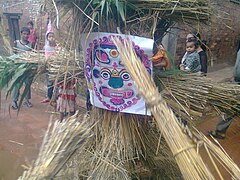
The current population of Nepal is 29,164,578 as per the 2021 census. The population growth rate is 0.92% per year.
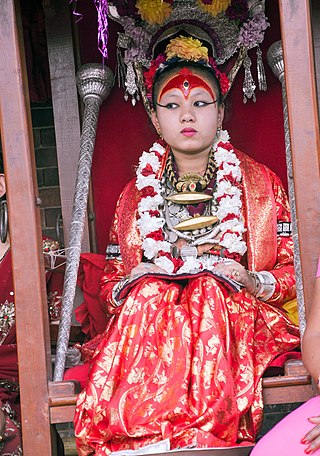
Kumari, Kumari Devi, or the Living Goddess is the tradition of worshipping a chosen virgin as manifestations of the divine female energy or Shakti in Dharmic Nepali religious traditions. It is believed that the girl is possessed by the goddess Taleju or Durga. The word Kumari is derived from Sanskrit meaning princess. The procession is akin to Indra or Sakra, taking Indrani to his celestial abode as his bride. The festival is celebrated during Kumari Jantra, which follows the Indra Jatri religious ceremony.

Newar or Newari, known officially in Nepal as Nepal Bhasa, is a Sino-Tibetan language spoken by the Newar people, the indigenous inhabitants of Nepal Mandala, which consists of the Kathmandu Valley and surrounding regions in Nepal.

Bhai Dooj, Bhai Tika, Bhaubeej, Bhai Beej, Bhai Phonta or Bhratri Dwitiya is a festival celebrated by Hindus on the second lunar day of the Shukla Paksha of Kartika, the eighth month of the Vikram Samvat Hindu calendar or the Shalivahana Shaka calendar. It is celebrated during the Diwali or Tihar festival and Holi festival. The celebrations of this day are similar to the festival of Raksha Bandhan.
Ranjitkar is one of the castes of Newar. The Newari caste system is divided according to profession. The Ranjitkar caste is concerned with the dyeing of clothes as well as other color related activities. The word "Ranjitkar" comes from Sanskrit origins crudely meaning "people concerned with colors" whereas the word "Chhipaa" is a Nepal Bhasa compound word which can be roughly translated as "color and allow to dry".

Hinduism is the main and largest religion of Nepal. In 2006, the country declared itself a secular country through democracy, after the abolition of its monarchy. According to the 2021 census, the Hindu population in Nepal is estimated to be around 23,677,744 which accounts for at least 81.19% of the country's population, the highest percentage of Hindus of any country in the world. Vikram Samvat, one of the two official calendars used in Nepal, is a solar Hindu calendar essentially the same to that widespread in North India as a religious calendar, and is based on Hindu units of time.
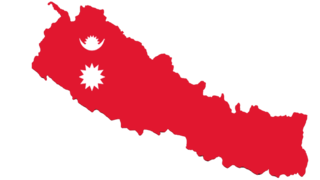
The culture of Nepal encompasses the various cultures belonging to the 125 distinct ethnic groups present in Nepal. The culture of Nepal is expressed through music and dance; art and craft; folklore; languages and literature; philosophy and religion; festivals and celebration; foods and drinks.

The Newar language of Nepal has the fourth oldest literature tradition among the Sino-Tibetan languages.

Bajrayogini Temple(Nepali: बज्रयोगिनी मन्दिर) is a Tantric Buddhist temple located at Sakwa in Nepal's Kathmandu Valley. It is also well known as Bodhisattva's Temple. The temple is actually a sort of temple complex, with the main temple having been built by King Pratap Malla in the sixteenth century. Vajrayogini is a Buddhist tantric deity, she is also conflated with Ugra Tara, a form of the Buddhist dharmapala Ekajati. However, the temple is sacred to both Buddhists and Hindus.
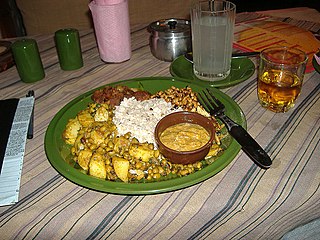
Baji is a type of beaten rice eaten in Nepal. The most common word for it, and the one visitors to Nepal will generally encounter, is "chiura." "Baji" is the term used by the Newar in the Kathmandu Valley. Rice is a staple in Nepal, as throughout South Asia. The grain is incorporated into everyday life, festivals, and rituals. Chiura is a common snack among farmers and workers in rural Nepal. The snack is made by pounding rice. The dish can be served with yogurt, curry, and or meat. Often chiura is paired with tea as a mid-morning snack in the fields.
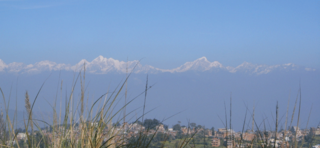
Dhulikhel is a municipality in Kavrepalanchok District of Nepal. Two major highway B.P. Highway and Araniko Highway passes through Dhulikhel. Araniko Highway connects Kathmandu, Nepal's capital city with Tibet's border town of Kodari. Dhulikhel is located at the Eastern rim of Kathmandu Valley, south of the Himalayas at 1550m above sea level and is situated 30 km southeast of Kathmandu and 74 km southwest of Kodari. The Majority of people in Dhulikhel are Newars, and Brahmin, Chhettri, Tamang and Dalit are also living in outer area of the town. Drinking water in Dhulikhel is some of the best water in Nepal. It was made with the help of the German NGO German Technical Cooperation.

Yomari Punhi is a Newari festival marking the end of the rice harvest. It takes place in November/December during the full moon day of Thinlā (थिंला), the second month in the lunar Nepal Era calendar.
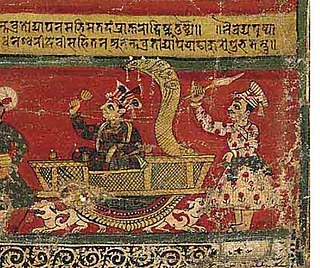
Ranajita Malla was the last king of the Malla dynasty who ruled Bhaktapur from 1722 to 1769. After his defeat by the Gorkhali forces of Prithivi Narayan Shah in 1769, he left for Varanasi. He is widely known for his contributions to Nepal Bhasa literature, in particular his plays are generally praised by modern scholars. He has been generally described as a peace loving, simple and religiously devoted monarch who allowed his citizens to advice and criticize him. However, his reign was characterized by constant disputes with Kantipur and Gorkha. He is also known for the crisis of succession during his reign when he favored his concubine's issue over his queen consort's, who more generally liked which caused a lot of mutiny in the kingdom especially in cities in like Thimi and Banepa.
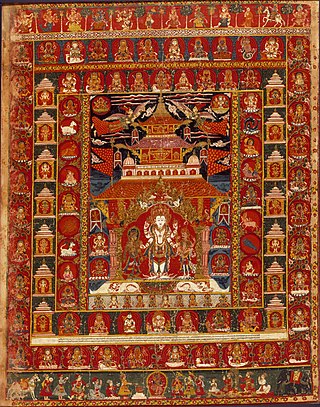
Nepalese Painting or Nepali Painting begins with the religious paintings with Hindu and Buddhist subjects, almost all Newa art by the Newari people of the Kathmandu valley. These traditional paintings can be found in the form of either wall paintings, cloth paintings called paubha, or manuscripts. They used conservative technique, style, and iconography in their works for centuries.

The ancient and refined traditional culture of Kathmandu, for that matter in the whole of Nepal, is an uninterrupted and exceptional meeting of the Hindu and Buddhist ethos practiced by its highly religious people. It has also embraced in its fold the cultural diversity provided by the other religions such as Kirat, Jainism, Islam and Christianity.
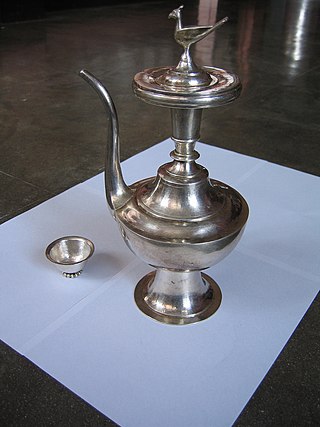
Aylā is a Newari beverage prepared by distillation of fermented ingredients such as rice, grains and millet. Apart from casual drinking, Aila is an important part of festivals in Nepal. This liquor is usually homemade and prepared by traditional methods. Its preparation is not yet commercial in Nepal, however it is sold in restaurant that serve Newa cuisine. It can be bought in local Newari restaurants. CNN has noted it as being one of the "50 most delicious drinks in the world".

Kwāti is a mixed soup of nine types of sprouted beans. It is a traditional Newari dish consumed on the festival of Guni Punhi, the full moon day of Gunlā which is the tenth month in the Nepal Era lunar calendar. It is also known and widely consumed as Gedagudi in the Mithila Region of Nepal, historically aligned down to Kingdom of Nepali people.

Dance is a performing art form consisting of purposefully selected sequences of human movement. Dance (Nepali: नृत्य/ नाच) in Nepal comprises numerous styles of dances, including folk, ethnic, classical to modern dances. Lakhey is the dance of a demon in the carnival of God. Durbar Square, a historic plaza in Kathmandu, Nepal, facing ancient palaces and adorned by Hindu temples, is always full of eager crowds on the last day of Indra Jatra, the festival celebrating Indra, the Hindu king of heaven. In this divine stage, Lakhe the demon dances among gods and deities relentlessly and carelessly.

Ghode Jatra(Nepali:घोडे जात्रा) is a horse festival native to Kathmandu. The festival occurs annually on mid March or early April.
